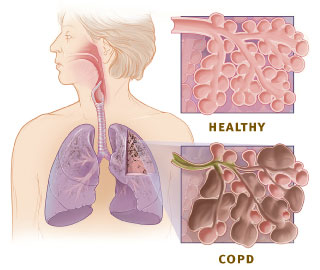At molecular level,
striated muscle (Heart Muscle is striated) consists of myofibrils (A
Protein), which are of two types-thick and thin myofilaments. A thick
filament containing myosin and a thin filament consisting of 3
different proteins: actin, tropomyosin, and troponin.
Cardiac troponin (cTn) is itself a complex of 3 protein subunits: troponin T (cTnT), troponin I (cTnI), and troponin C (cTnC). Troponin T binds the troponin complex to tropomyosin. Troponin I inhibits actomyosin ATPase in relation to the calcium concentration. Troponin C, with its 4 binding sites for calcium, mediates calcium dependency.
In resting state, tropomyosin winds over to cover the binding sites on the actin; can be imagined like a cover that wind over the facets (where the myosin head would like to lock itself). Here, cTnT can be imagined as several nails that fix tropomyosin over the actin.
With release of calcium from the cytosol of muscle cells cTnC attaches 4 Ca+ to the 4 binding sites on it, in turn activates cTnI that lifts the inhibition of ATPase in the myosin head; myosin, after getting energy from hydrolysis of ATP, goes for conformational changes of its' head and crawls over the actin molecule, thereby contraction of muscle occurs.
In a over simplified way, it can be said that an activated troponin complex removes the tropomysin cover from the actin, thereby unblocks the binding sites for myosin. Myosin head crawls over the facets on the actin, and pulls the actin to cause a contraction of the myofibril.
In the cytosol, troponin T
is found in both free and protein-bound forms. The unbound (free)
pool of troponin T is the source of the troponin T released in the
early stages of myocardial damage. Bound troponin T is released from
the structural elements at a later stage, corresponding with the
degradation of myofibrils that occurs in irreversible myocardial
damage.
The most common cause of cardiac injury is myocardial ischemia, ie, acute myocardial infarction. Troponin T becomes elevated 2 to 4 hours after the onset of myocardial necrosis, and can remain elevated for up to 14 days.
Elevations in troponin T are also seen in patients with unstable angina. The finding of unstable angina and an elevated troponin T are known to have adverse short- and long-term prognoses, as well as a unique beneficial response to an invasive interventional strategy and treatment with the newer anti-platelet agents and low-molecular-weight heparin.
Useful For: cTnT and cTnI are useful for the exclusion of diagnosis of acute myocardial infarction. Monitoring of acute coronary syndromes and estimating prognosis. Possible utility in monitoring patients with non-ischemic causes of cardiac injury.
Cardiac troponin (cTn) is itself a complex of 3 protein subunits: troponin T (cTnT), troponin I (cTnI), and troponin C (cTnC). Troponin T binds the troponin complex to tropomyosin. Troponin I inhibits actomyosin ATPase in relation to the calcium concentration. Troponin C, with its 4 binding sites for calcium, mediates calcium dependency.
In resting state, tropomyosin winds over to cover the binding sites on the actin; can be imagined like a cover that wind over the facets (where the myosin head would like to lock itself). Here, cTnT can be imagined as several nails that fix tropomyosin over the actin.
With release of calcium from the cytosol of muscle cells cTnC attaches 4 Ca+ to the 4 binding sites on it, in turn activates cTnI that lifts the inhibition of ATPase in the myosin head; myosin, after getting energy from hydrolysis of ATP, goes for conformational changes of its' head and crawls over the actin molecule, thereby contraction of muscle occurs.
In a over simplified way, it can be said that an activated troponin complex removes the tropomysin cover from the actin, thereby unblocks the binding sites for myosin. Myosin head crawls over the facets on the actin, and pulls the actin to cause a contraction of the myofibril.
 |
| English: This is a recropped image originally created by Hank van Helvete (Photo credit: Wikipedia) |
The most common cause of cardiac injury is myocardial ischemia, ie, acute myocardial infarction. Troponin T becomes elevated 2 to 4 hours after the onset of myocardial necrosis, and can remain elevated for up to 14 days.
Elevations in troponin T are also seen in patients with unstable angina. The finding of unstable angina and an elevated troponin T are known to have adverse short- and long-term prognoses, as well as a unique beneficial response to an invasive interventional strategy and treatment with the newer anti-platelet agents and low-molecular-weight heparin.
Useful For: cTnT and cTnI are useful for the exclusion of diagnosis of acute myocardial infarction. Monitoring of acute coronary syndromes and estimating prognosis. Possible utility in monitoring patients with non-ischemic causes of cardiac injury.
...
Click here to Subscribe news feed from "Clinicianonnet; so that you do not miss out anything that can be valuable to you !!
...







